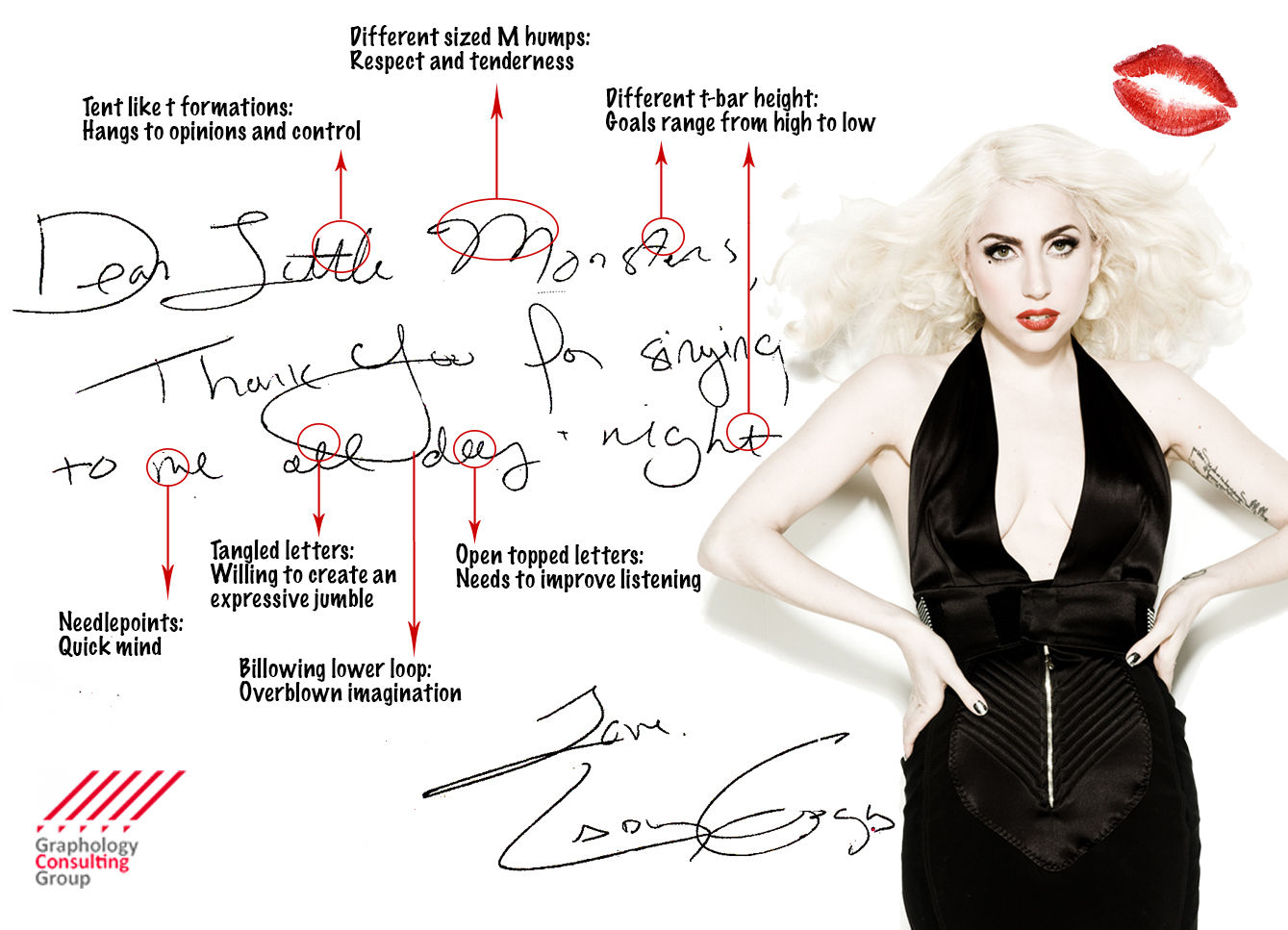Sunday, December 15, 2019
Saturday, December 7, 2019
Tuesday, November 26, 2019
Dasar - dasar Grafologi
https://www.idntimes.com/hype/fun-fact/tita/grafologi-intip-kepribadiannya-lewat-tulisan-tangannya/full
Siantita Novaya

Sumber gambar: pixabay.com










Siantita Novaya

Sumber gambar: pixabay.com
Grafologi adalah ilmu yang mempelajari tentang tulisan tangan. Istilah grafologi sendiri pertama kali digunakan pada tahun 1875 dan berasal dari bahasa Yunani yaitu grapho yang berarti tulisan dan logo yang berarti ilmu.
Tujuan mempelajari tulisan adalah mengungkap karakter dan kepribadian lewat seseorang lewat tulisan tangannya. Kepribadian yang dimaksud di sini adalah kelemahan, kelebihan dan kekuatan yang ada pada diri seseorang. Hal seperti ini bisa diketahui karena tulisan tangan muncul dari alam bawah sadar sehingga mampu memberikan informasi yang berharga untuk mengungkap karakter seseorang.

Sumber gambar: graphologyconsulting.com/
Tahukah kamu bahwa grafologi bisa mengungkap kepribadian seseorang hingga 80 persen akurat? Mungkin dari 10 karakter yang terungkap, 8 benar dan sisanya salah. Maka itu, sebenarnya tolok ukur benar, pas, cocok dan akurat lebih bersifat subjektif. Karakter yang tak sesuai sebenarnya memang benar dimiliki orang yang bersangkutan hanya saja ia belum menyadarinya. Bisa saja benar atau orang tersebut tidak merasa.
Mau tahu gimana caranya membaca karakter seseorang? Simak uraian berikut ini!
1. Besar kecilnya tulisan

Sumber gambar: pixabay.com
Kecil: Pendiam, sering menyendiri namun memiliki otak yang cemerlang dan selalu berpikir ilmiah. Orang seperti ini logikanya berjalan lebih baik dari orang kebanyakan. Orang dengan tulisan kecil menunjukkan bahwa penulisnya adalah orang yang mandiri.
Sedang: Penulisnya memiliki karakter yang terpaku pada tradisi kuno dan sangat ahli dalam menggunakan logikanya untuk mengambil keputusan.
Besar: Semakin besar tulisan seseorang maka akan semakin besar ambisinya dan selalu ingin diperhatikan orang lain dan suka berbicara.
Sangat besar: Orang dengan tulisan yang sangat besar menunjukkan bahwa ia gemar membuat perhatian untuk sekitarnya, selalu ingin tampil di depan dan berpetualang ke mana-mana.
2. Gaya penulisan

Sumber gambar: pixabay.com
Sambung biasa: Biasanya orang seperti ini senang membantu orang lain dan bisa menerima setiap ide yang diberikan, mudah bergaul dan banyak teman.
Sambung petak: Penulis seperti ini biasanya mudah dipengaruhi dan sering kali menganggap remeh setiap masalah dan sembrono.
Sambung berliku: Tulisan seperti ini mencerminkan bahwa pemiliknya adalah pendiam, berhati-hati, dan biasanya memiliki bakat khusus.
Lurus dan lancip: Tulisan dengan gaya seperti ini menunjukkan bahwa penulisnya adalah orang yang agresif dan tekun, kadang malah tak ingin berkompromi dengan orang lain. Jika tulisannya lancip di awal maka orang telah banyak mengalami konflik psikologis sehingga bersikap agresif.
Campuran: Tulisan seperti ini menunjukkan bahwa pemiliknya berpikir cepat, bahkan jika kamu sulit membacanya, menunjukkan bahwa pemilik tulisan seperti ini kreatif namun paling tersinggung jika dikritik. Bahkan jika ada hal yang tak sesuai dengan kemauannya maka ia tak akan segan untuk mengabaikan begitu saja.
3. Kemiringan penulisan

Sumber gambar: pixabay.com
Kiri: Penulis dengan kemiringan ke kiri menunjukkan bahwa ia adalah seorang introvert. Ia akan menilai sesuatu berdasarkan pengukuran masa lampau yang mungkin pernah ia alami sebelumnya. Selain konservatif, orang seperti ini juga individualis.
Kanan: Berlawanan dengan kiri, tulisan yang miring ke kanan menunjukkan bahwa ia adalah ekstrovert yang ramah, aktif dan terbuka saat menghadapi tantangan baru. Jika tak mengerti satu hal, ia tak ragu untuk bertanya pada yang lebih ahli.
Tegak: Jika tulisannya tegak maka penulisnya adalah tipe orang yang tak suka diatur. Ia dan pikirannya adalah miliknya sendiri, kebebasan adalah hal yang paling ia utamakan. Meski tak ingin diatur namun ia tetap bisa mengontrol dirinya sendiri.
4. Tekanan tulisan

Sumber gambar: pexels.com
Perhatikan bekas tulisan di balik kertas yang digunakan untuk menulis. Semakin jelas tekanan yang ditimbulkan pada kertas maka akan semakin kaku dan formal karakter penulisnya, biasanya orang dengan tekanan jelas pada kertas menunjukkan bahwa ia juga susah untuk menyesuaikan diri, namun baginya penting untuk bersikap demikian agar orang lain menghargainya.
Namun jika hampir tak ditemukan bekas tulisan di balik kertas, maka pembawaan penulisnya adalah tenang dan pandai membawa diri. Ia tak mudah tersulut emosi dan selalu berusaha untuk menggunakan logikanya dalam setiap pengambilan keputusan.
5. Bentuk huruf awal

Sumber gambar: pixabay.com
Bentuk jangkar: Disebut jangkar karena bentuk huruf awal seperti jangkar. Penulis yang memiliki awalan seperti jangkar menunjukkan bahwa ia belum bisa bersikap dewasa dan kurang percaya diri dalam menjalani hidup dan sedikit pasif.
Bentuk busur: Disebut busur karena awalannya membentuk busur ditarik. Pemiliki tulisan seperti ini biasanya mudah terpuaskan dengan pencapaian-pencapaian kecil dan cukup religius.
Bentuk memanjang: Bentuk huruf awal yang memanjang menunjukkan bahwa ia berhati-hati dalam merencanakan masa depan. Semakin panjang huruf maka akan semakin boros waktu yang sering ia gunakan untuk beraktifitas.
6. Bentuk huruf akhir

Sumber gambar: unsplash.com
Memanjang: Orang tersebut memiliki kemurahan hati dan rasa sosialnya cukup besar.
Memanjang ke atas: Penulisnya menyukai kemewahan dan memiliki semangat yang tinggi.
Menyilang: Penulisnya tak segan untuk mengkritik diri sendiri jika ia memang salah dan keliru.
7. Jarak vertikal antar tulisan

Sumber gambar: unsplash.com
Sangat jauh: Penulisnya cenderung menutup diri dan mungkin anti sosial.
Cukup berjarak sehingga tak bersentuhan dengan baris bawahnya: Pribadi yang boros dan suka berbicara.
Rapat, sehingga saling bersentuhan: Penulisnya adalah organisator yang baik.
8. Penggunaan huruf ‘t’

Sumber gambar: teengazette.com
Letak palang (-) pada kail ‘t’ yang ke kiri: Pribadi yang waspada dan tak mudah percaya.
Ke tengah: Pribadi yang tidak terlalu kreatif namun bertanggung jawab.
Cenderung ke kanan: Handal, teliti, dan mampu memimpin.
Panjang kail ‘t’ menunjukkan kemampuan potensial untuk mencapai target.
Tinggi rendah palang (-) pada kail ‘t’ rendah: Kurang percaya diri dan pemalas.
Tinggi: Target hidup tinggi namun juga diimbangi dengan kemampuan.
Saat menulis, secara tak kita sadari gerakan tangan dipengaruhi oleh proses psikis yang ada dalam diri. Maka itu bisa dikatakan bahwa tulisan mampu mencerminkan kepribadian seseorang, karena kondisi psikis kita keluar dan terekam dalam tulisan. Dan tak mustahil pula jika kita bisa mengubah karakter seseorang dengan mengubah cara menulisnya.
Nah, setelah mengetahui cara membaca karakter berdasarkan tulisan, apakah kamu bisa membaca karakter tulisan di bawah ini?

Sumber gambar: idntimes.com
Thursday, August 8, 2019
UK Influencer Oliver Isaacs Shares How to Go Viral on Today’s Internet

https://socialmarketingsolutions.com/2018/12/07/uk-influencer-oliver-isaacs-shares-how-to-go-viral-on-todays-internet/
Written by Social Marketing SolutionsPosted on December 7, 2018
When it comes to going viral on the Internet, there may not be a bigger expert on the planet than Oliver Isaacs. He is a serial entrepreneur, social media guru, and a top influencer in the UK. Oliver’s social media pages are well known and regularly reach millions of users every month. He has given business advice and motivational stories for high-profile entrepreneurs like Tony Robbins, Mark Cuban, and Tim Ferris.
It was a thrill to speak to Oliver last week and learn more about what he is up to and has uncovered about going viral on today’s crowded internet.
John White: Your company, Amirite, has become known as the place where the Internet meme was born, Internet slang became commonplace, and earlier influencers were created. What’s the future look like for the platform?
Oliver Isaacs: Whilst the dominance of Facebook, Reddit, Instagram, and Snapchat can’t be disputed, we believe that the Internet is still in the early stages compared to what it will be, and there is still opportunity around for network-based sites to gain market share and reach millions of users across the web.
We would describe Amirite as a mix between Reddit, Twitter, and Quora. It differs from Facebook and Twitter as user opinions are voiced straight to the viral world, while simultaneously people can build strong tight-knit communities and form long-term friendships with different people from all over the world, offering the best of both Twitter’s openness and Facebook’s community spirit.
There are currently millions of user comments, and nearly a billion votes have already been processed on the site. In terms of the future of the site, we have received significant interest from a number of key players in the investing world to expand the site, and whilst we are open to partnerships, our main focus is growing the site to ensure it achieves its full potential.
What we are trying to do with Amirite is different and fill a gap in the market, focusing solely on people’s opinions and thoughts, whilst leveraging the power of social networks to drive traffic to the site. Our number one priority is user satisfaction and enjoyment, which will ultimately lead to user growth.
White: Having seen content go viral on your site and social pages so many times, you have become quite an expert on the types of content that is both clickable and shareable. However, with social media more crowded than ever, it seems to be getting harder and harder to create viral content.
Yet, every day there are people who crack the code and get millions of views on their videos, blogs, and links. What makes content go viral today?
Isaacs: Great question. It’s true social media is more crowded than ever, and it’s getting harder to stand out now that more and more people are getting clued up and realising the power of online content. Obviously, if you got into the game early and managed to build your own large following like Logan Paul or PewDiePie did, the potential reach of your video or link is going to be much greater than someone just starting out. In this game, it’s all about networks and relationships.
Whether it’s your share-for-share partnership network on Facebook, your Engagement groups on Instagram, or your cross-promotion network on YouTube, ensuring your content has the best chance of going viral ultimately comes down to how strong your network is.
Once you have managed to build a solid following and network, whether your video, blog, meme or link goes viral comes down to the nature of the content. To make something viral, it needs to stand out, and there are a number of characteristics that all viral content tends to have in common:
1. Surprising content tends to generate the best responses, and more people are likely to share something unexpected.
2. An inspirational video or feel-good video generally does very well as well. Everyone wants to take some time out and feel great, especially in the hectic world we live in, and anything that engages our positive emotions is likely to reach the masses.
3. Any content relating to current affairs that is newsworthy is likely to be engaging and memorable. It also has the best chance of being picked up by news outlets, which will attract cross-network traffic across multiple platforms. Additionally, videos, blogs, and links that appeal to universal niches like travel, fitness, pets, luxury, motivation, and food are often the ones that keep cropping up in people’s newsfeeds.
4. Content that is touching and creates strong empathy is also likely to do well. If a connection is established between the content and reader, not only is the network or influencer going to attract new followers, they are also going to gain a more loyal following, which will ultimately lead to more people sharing in the future too.
5. Content that is simple, visually appealing, easy to understand, and shareable is also key. Sometimes people forget about the basics and try and make things more complicated than they need to be. I’ve seen very simple comedy videos do very well, and the genius behind the simplicity is what made them be seen by tens of millions.
White: You’ve worked with some of the most well-known entrepreneurs and social media influencers in the world helping grow their followers by the millions. What’s the one tip you would give to other entrepreneurs who want to grow a large following online and become an influencer in their industry and beyond?
Isaacs: There are now more people than ever wanting to become influencers, with the rise of Instagram stories, Facebook pages, YouTube, and Snapchat. Whilst this has definitely made the market more crowded, this has meant that people need to stand out and up their game to ensure eyeballs are on them. A lot of potential influencers, when starting out, don’t realise the magnitude of the task ahead. I’ve seen many influencers fall by the wayside. Building a loyal following takes time, and learning how the algorithms work on each platform also takes time and effort.
From first-hand experience, I know it’s extremely difficult to grow and cultivate your following across multiple platforms at the same time. Saying that, I would recommend diversifying across all platforms to begin with, and once you have found one that suits your niche, I would concentrate on growing there; for example, comedy videos tend to do best on Facebook and Instagram, music-type videos do very well on YouTube, and travelling and modelling are best suited to Instagram.
So the main advice I would give to a potential influencer looking to grow a following in the millions is to ensure you are the right character who does not give up easily. If you’re not determined and prepared to fail before you succeed, you’re already at a disadvantage.
White: Instagram has been a platform you’ve had massive success with both personally and for your clients. Why should entrepreneurs be using Instagram to grow their brand, and what can they do to stick out on the platform?
Isaacs: Very few people in the startup, investing, and tech space have large followings on Instagram. That’s the main reason I chose to focus the influencer side of my business on Instagram first. As mentioned earlier, in this game it’s important to stand out and try to be different. My following has reached a few hundred thousand followers on Instagram very quickly, and I believe one of the main reasons for this is because my content and daily stories on investing, business, life, and motivation have been unique to the platform.
Entrepreneurs and businesses should definitely make use of Instagram. Mobile has now taken over desktop traffic, and Instagram is the place to be. Not only is the user base massive (over 800 million active users), but the users are much more loyal compared to say, Snapchat. If you have a visually appealing business, there is no question you should target Instagram. Instagram is also marketer friendly, where you can track your analytics and drive traffic to your page. There is no doubt you can enhance your brand identity significantly.
In order to stick out on the platform, you need to have clear goals in mind. Are you interested in monetising? Do you want to become an influencer in a specific niche? Do you want to drive traffic to your business website? The niches that do best on the platform are travel, fitness, comedy, motivation, luxury, quotes, and fashion. There are numerous strategies and tactics you can use to grow your following and stand out. My 5 favourite are:
1) Cross-promote to grow your following
If you’re using Facebook, Snapchat, Twitter, YouTube or another platform, you’ll want to give maximum coverage to your Instagram page. You can do this with shout-outs, screenshots in Snapchat stories, and embedding your username logo in Facebook and YouTube videos.
2) Ensure you maximise the use of hashtags
Hashtags are one of the most important features of Instagram. They ensure your content is exposed to a larger audience. Using the right hashtags will increase your potential for new likes, followers, and engagement. My advice is to try and focus on specific and less-crowded hashtags and make sure you use the 30-hashtag limit on all posts. Stay away from obvious and well-known keyword hashtags, as your post is unlikely to be seen due to the saturated world of well-known keywords.
3) Geo-tag in Instagram stories
The introduction of Instagram geo-tags in stories has introduced a new way to grow your page. Adding your specific location to your story could lead to your story appearing in the location’s specific page story, thereby increasing your exposure to new followers using this unique strategy.
4) Follow high-engaging followers
Not many people use this unique strategy but it is very effective. Find the top 20 popular accounts in your specific niche, or go to the recent posts when searching popular hashtags and follow all the people who engage with the content. Using this method, you can attract high-engaging followers to your account, which will enable your account to grow much more effectively.
5) Strategic shout-outs (S4S)
Find accounts in the same niche as you are and ask if they are interested in s4s or in other words shout-out for shout-out. By using the Instagram DM, Telegram or Kik apps, you can find many accounts in your specific niche. You can also make use of “powerlikes” from much larger accounts, if you build a solid relationship with the account owners of these 1m+ pages. Or you can offer to promote them on another platform, by leveraging your following on other networks.
White: In our conversation, you made it clear that brands can never ignore the massive potential for reach on the world’s largest social network, Facebook. You have created several Facebook pages that have developed massive followings and achieved millions of impressions each month. What advice would you give to those who are attempting to crack Facebook’s algorithm, but maybe haven’t had the success that you’ve had?
Isaacs: You’re right – Facebook is king, and there is no doubt brands and influencers alike should make the most of it. In addition to the points I mentioned earlier about the importance of building relationships and the traits of viral content, there are a number of unique aspects to Facebook and a number of strategies you can use to increase your organic reach, which will position your page well for growth:
1) Avoid posting links on posts and especially stay away from YouTube links. Facebook and YouTube are “at war,” and YouTube links can have an extremely low organic reach. Posting links, especially affiliate links, can have a detrimental effect on your page’s algorithm “EdgeRank.”
2) Stay on Facebook Live for at least 20 minutes a week. This can increase your page’s “EdgeRank,” meaning future posts will have a better chance of appearing high in newsfeeds. Facebook has already introduced stories to public figures and celebrities, so their followers can now watch their daily story. When Facebook eventually introduces stories for pages, I would recommend making the most of this feature too.
3) Join Share for Share groups and build relationships with significant pages and influencers. If large pages like Ladbible, Unilad, 9gag, Daily mail, and similar content creators in your niche are sharing or cross-promoting your content, your content reach is going to increase dramatically. One strategy to discover pages that share is to click on the profiles of people who are sharing your videos and see what other videos from other pages they’ve liked, commented on, and shared. Ultimately on Facebook, it all comes down to sharing. When publishing your content, you need to ask yourself, are people likely to share this?
Saturday, July 13, 2019
10 Keterampilan Komunikasi Modern
https://linguabahasa.id/keterampilan-komunikasi/

Komunikasi adalah proses pertukaran informasi antara pengirim dan penerima dengan menggunakan media—tulis, lisan, visual, atau elektronik. Dalam proses tersebut, banyak hal yang mungkin menggagalkan transfer pesan. Untuk memastikan pesan diterima dengan baik, baik komunikator (penyampai pesan) maupun komunikan (penerima pesan) memerlukan keterampilan komunikasi. Di dunia modern, keterampilan komunikasi menjadi keunggulan dalam karier dan bisnis. Apa saja keterampilan komunikasi modern yang harus dikuasai seseorang agar dapat sukses? Artikel ini mengulas sepuluh keterampilan komunikasi yang diharapkan dari seorang karyawan menurut Thill dan Bovee (Excellence in Business Communication 12th ed., 2017, hlm. 7)

Sepuluh Keterampilan Komunikasi Modern
1. Mengenali Kebutuhan Informasi
Pengenalan kebutuhan informasi adalah langkah awal yang mutlak diperlukan sebelum mencarinya. Pencarian jawaban lebih mudah dilakukan ketika pertanyaan yang diajukan sudah dirumuskan dengan jelas. Setelah perumusan kebutuhan informasi, sumber informasi yang dapat diandalkan untuk kebutuhan itu perlu dicari secara efisien.
2. Mengatur Informasi dan Ide secara Logis dan Lengkap
Setelah diperoleh, informasi dirangkai menjadi ide yang logis dan lengkap. Luapan informasi kadang membuat orang kehilangan fokus dan teralihkan dari tujuan awal. Informasi yang sudah ditemukan harus diatur secara logis dan lengkap. Keteraturan informasi ini akan memudahkan proses pematangan ide berdasarkan informasi yang ada.
3. Menyampaikan Ide secara Koheren dan Persuasif
Seberapa pun briliannya suatu ide, ide tersebut kurang berguna jika tidak dapat disampaikan secara koheren dan persuasif. Koherensi membuat berbagai informasi saling berpaut untuk mendukung ide. Keterhubungan ini akan membuat argumen yang dikemukakan lebih logis dan persuasif. Persuasi yang koheren memudahkan penerimaan ide dalam suatu presentasi.
4. Menyimak secara Aktif
Menyimak sebagai keterampilan pasif lisan kerap luput dari perhatian, misalnya menyimak sebelum berbicara dalam suatu rapat. Padahal, informasi yang diperoleh dari hasil menyimak diperlukan sebagai asupan yang nantinya akan diolah menjadi bahan komunikasi aktif. Keterampilan menyimak yang diperlukan adalah menyimak secara aktif yang membuat informasi dapat diperoleh dengan lebih lengkap.
5. Berkomunikasi dengan Berbagai Kalangan Orang
Komunikator yang baik dapat berkomunikasi dengan orang dari berbagai latar belakang dan pengalaman. Cara berkomunikasi ditentukan oleh berbagai faktor seperti pesan yang disampaikan, audiens yang dihadapi, dan media komunikasi. Keterampilan untuk menentukan cara berkomunikasi menjadi kunci sukses penyampaian pesan
6. Memakai Teknologi Komunikasi secara Efektif dan Efisien
Perkembangan teknologi komunikasi menuntut penguasaan terus-menerus terhadap teknologi baru. Sebagai alat komunikasi, teknologi perlu digunakan secara efektif dan efisien. Yang terpenting bukanlah penguasaan teknologi komunikasi, melainkan pemakaiannya untuk mencapai hasil yang diinginkan dengan sumber daya yang optimal.
7. Menggunakan Bahasa Berstandar Tinggi
Bahasa tidak hanya digunakan untuk menyampaikan pesan, tetapi juga untuk menunjukkan mutu seorang komunikator. Inilah esensi istilah bahasa yang baik dan benar. Baik artinya sesuai konteks, yaitu dengan siapa dan dalam lingkungan apa bahasa diterapkan. Benar artinya sesuai kaidah, yaitu standar ejaan, tata bahasa, dan aspek lain bahasa.
8. Bersikap Santun dan Etis
Kesantunan dan etika melancarkan komunikasi bisnis. Pesan lebih mudah diterima saat disampaikan dengan menjunjung prinsip kesantunan, bahkan ketika pesan itu bersifat negatif atau berpeluang untuk ditolak, misal. Etika bisnis menimbulkan rasa saling menghormati yang berpengaruh besar terhadap kemudahan penerimaan pesan.
9. Mengelola Waktu dan Sumber Daya secara Efisien
“Waktu adalah uang”, demikian ungkapan yang kerap didengar. Setiap hari kita bergulat untuk memanfaatkan waktu dan sumber daya terbatas yang dimiliki untuk berbagai keperluan, termasuk untuk berkomunikasi. Waktu dan sumber daya yang dialokasikan untuk berbagai keperluan komunikasi, misalnya mencari informasi dan menyampaikan ide, harus dikelola dengan efisien.
10. Berpikir Kritis
Informasi tidak dapat langsung ditelan mentah-mentah. Evaluasi informasi secara menyeluruh dan objektif harus dilakukan agar dapat menghasilkan simpulan yang logis dan rekomendasi yang tepat. Di sinilah peran pemikiran kritis. Berpikir kritis didefinisikan secara sederhana sebagai analisis fakta untuk membentuk penilaian. Proses ini kompleks dan memerlukan berbagai keterampilan lain.

Komunikasi adalah proses pertukaran informasi antara pengirim dan penerima dengan menggunakan media—tulis, lisan, visual, atau elektronik. Dalam proses tersebut, banyak hal yang mungkin menggagalkan transfer pesan. Untuk memastikan pesan diterima dengan baik, baik komunikator (penyampai pesan) maupun komunikan (penerima pesan) memerlukan keterampilan komunikasi. Di dunia modern, keterampilan komunikasi menjadi keunggulan dalam karier dan bisnis. Apa saja keterampilan komunikasi modern yang harus dikuasai seseorang agar dapat sukses? Artikel ini mengulas sepuluh keterampilan komunikasi yang diharapkan dari seorang karyawan menurut Thill dan Bovee (Excellence in Business Communication 12th ed., 2017, hlm. 7)

Sepuluh Keterampilan Komunikasi Modern
1. Mengenali Kebutuhan Informasi
Pengenalan kebutuhan informasi adalah langkah awal yang mutlak diperlukan sebelum mencarinya. Pencarian jawaban lebih mudah dilakukan ketika pertanyaan yang diajukan sudah dirumuskan dengan jelas. Setelah perumusan kebutuhan informasi, sumber informasi yang dapat diandalkan untuk kebutuhan itu perlu dicari secara efisien.
2. Mengatur Informasi dan Ide secara Logis dan Lengkap
Setelah diperoleh, informasi dirangkai menjadi ide yang logis dan lengkap. Luapan informasi kadang membuat orang kehilangan fokus dan teralihkan dari tujuan awal. Informasi yang sudah ditemukan harus diatur secara logis dan lengkap. Keteraturan informasi ini akan memudahkan proses pematangan ide berdasarkan informasi yang ada.
3. Menyampaikan Ide secara Koheren dan Persuasif
Seberapa pun briliannya suatu ide, ide tersebut kurang berguna jika tidak dapat disampaikan secara koheren dan persuasif. Koherensi membuat berbagai informasi saling berpaut untuk mendukung ide. Keterhubungan ini akan membuat argumen yang dikemukakan lebih logis dan persuasif. Persuasi yang koheren memudahkan penerimaan ide dalam suatu presentasi.
4. Menyimak secara Aktif
Menyimak sebagai keterampilan pasif lisan kerap luput dari perhatian, misalnya menyimak sebelum berbicara dalam suatu rapat. Padahal, informasi yang diperoleh dari hasil menyimak diperlukan sebagai asupan yang nantinya akan diolah menjadi bahan komunikasi aktif. Keterampilan menyimak yang diperlukan adalah menyimak secara aktif yang membuat informasi dapat diperoleh dengan lebih lengkap.
5. Berkomunikasi dengan Berbagai Kalangan Orang
Komunikator yang baik dapat berkomunikasi dengan orang dari berbagai latar belakang dan pengalaman. Cara berkomunikasi ditentukan oleh berbagai faktor seperti pesan yang disampaikan, audiens yang dihadapi, dan media komunikasi. Keterampilan untuk menentukan cara berkomunikasi menjadi kunci sukses penyampaian pesan
6. Memakai Teknologi Komunikasi secara Efektif dan Efisien
Perkembangan teknologi komunikasi menuntut penguasaan terus-menerus terhadap teknologi baru. Sebagai alat komunikasi, teknologi perlu digunakan secara efektif dan efisien. Yang terpenting bukanlah penguasaan teknologi komunikasi, melainkan pemakaiannya untuk mencapai hasil yang diinginkan dengan sumber daya yang optimal.
7. Menggunakan Bahasa Berstandar Tinggi
Bahasa tidak hanya digunakan untuk menyampaikan pesan, tetapi juga untuk menunjukkan mutu seorang komunikator. Inilah esensi istilah bahasa yang baik dan benar. Baik artinya sesuai konteks, yaitu dengan siapa dan dalam lingkungan apa bahasa diterapkan. Benar artinya sesuai kaidah, yaitu standar ejaan, tata bahasa, dan aspek lain bahasa.
8. Bersikap Santun dan Etis
Kesantunan dan etika melancarkan komunikasi bisnis. Pesan lebih mudah diterima saat disampaikan dengan menjunjung prinsip kesantunan, bahkan ketika pesan itu bersifat negatif atau berpeluang untuk ditolak, misal. Etika bisnis menimbulkan rasa saling menghormati yang berpengaruh besar terhadap kemudahan penerimaan pesan.
9. Mengelola Waktu dan Sumber Daya secara Efisien
“Waktu adalah uang”, demikian ungkapan yang kerap didengar. Setiap hari kita bergulat untuk memanfaatkan waktu dan sumber daya terbatas yang dimiliki untuk berbagai keperluan, termasuk untuk berkomunikasi. Waktu dan sumber daya yang dialokasikan untuk berbagai keperluan komunikasi, misalnya mencari informasi dan menyampaikan ide, harus dikelola dengan efisien.
10. Berpikir Kritis
Informasi tidak dapat langsung ditelan mentah-mentah. Evaluasi informasi secara menyeluruh dan objektif harus dilakukan agar dapat menghasilkan simpulan yang logis dan rekomendasi yang tepat. Di sinilah peran pemikiran kritis. Berpikir kritis didefinisikan secara sederhana sebagai analisis fakta untuk membentuk penilaian. Proses ini kompleks dan memerlukan berbagai keterampilan lain.
Tuesday, May 28, 2019
The Family Firm
http://content.time.com/time/world/article/0,8599,2056697,00.html
By JOHN COLMEY and DAVID LIEBHOLD
Jakarta, Monday, May 24, 1999
By JOHN COLMEY and DAVID LIEBHOLD
Jakarta, Monday, May 24, 1999
When the end came for Suharto, Indonesia's long-serving President appeared oddly passive. As students and angry mobs took to the streets and soldiers responded with gunfire and tear gas, the five-star general hovered in the background, making few attempts to set things right. When he finally quit a year ago this week, he stood meekly to the side as his successor, B.J. Habibie, took the oath of office. Suharto has hardly been heard from since.
But Indonesia's onetime autocrat has been far busier than most of his countrymen realize. Just after his fall from power there began feverish movements of his personal fortune. In July 1998, reports emerged that a staggering sum of money linked to Indonesia had been shifted from a bank in Switzerland to another in Austria, now considered a safer haven for hush-hush deposits. The transfer caught the attention of the United States Treasury, which tracks such movements, and set in motion diplomatic inquiries in Vienna. Now, as part of a four-month investigation that covered 11 countries, TIME has learned that $9 billion of Suharto money was transferred from Switzerland to a nominee bank account in Austria. Not bad for a man whose presidential salary was $1,764 a month when he left office. (Suharto, for his part, denies that he has any bank deposits abroad and insists that his wealth amounts to a mere 19 hectares of land in Indonesia, plus $2.4 million in savings.)
Those billions are just part of the Suharto wealth. Though the Asian financial crisis has trimmed the family empire considerably, the former President and his children retain a staggering fortune. It was built over three decades from a skein of companies, monopolies and control over vast sectors of economic activity in Indonesia--from oil exports to humble pilgrims making the yearly visit to Mecca. (They flew on planes leased from companies controlled by Suharto's children.) According to data from the National Land Agency and Properti Indonesia magazine, the Suharto family on its own or through corporate entities controls some 3.6 million hectares of real estate in Indonesia, an area larger than Belgium. That includes 100,000 sq m of prime office space in Jakarta and nearly 40% of the entire province of East Timor.
Within Indonesia, the six Suharto offspring have significant equity in at least 564 companies, and their overseas interests include hundreds of other firms, scattered from the U.S. to Uzbekistan, the Netherlands, Nigeria and Vanuatu. The Suhartos also possess plenty of the trappings of wealth. In addition to a $4 million hunting ranch in New Zealand and a half-share in a $4 million yacht moored outside Darwin, Australia, youngest son Hutomo Mandala Putra (nicknamed Tommy) owns a 75% stake in an 18-hole golf course with 22 luxury apartments in Ascot, England. Bambang Trihatmodjo, Suharto's second son, has an $8 million penthouse in Singapore and a $12 million mansion in an exclusive neighborhood of Los Angeles, two doors down from rock star Rod Stewart and just up the street from his brother Sigit Harjoyudanto's $9 million home. Eldest daughter Siti Hardiyanti Rukmana may have sold her Boeing 747-200 jumbo jet, but the family's fleet of planes included, at least until recently, a DC-10, a blue-and-red Boeing 737, a Canadian Challenger 601 and a BAC-111. The latter once belonged to the Royal Squadron of Britain's Queen Elizabeth II, according to Dudi Sudibyo, managing editor of Indonesia's Angkasa aerospace magazine.
Neither Suharto nor his six children responded to requests for interviews, though lawyers for the former President and son Bambang asserted that their clients did nothing illegal. Indeed, no one has proven that the Suhartos broke any laws. Their companies mostly consist of operating entities that turn profits, create jobs and import Western technology. Yet allegations that the former First Family benefited from favoritism, commonly heard in Indonesia since the early 1980s, began to grow louder when the former President resigned. His successor quickly announced an official investigation into such charges. Tommy, the youngest son whose corporate empire at one point included the Lamborghini sports car company, is already in legal jeopardy, facing charges of defrauding a state agency of $11 million in a real estate deal. The South Jakarta district court recently rejected a plea from Tommy's lawyers that he be tried in a civil court and is proceeding with a criminal trial.
In an interview at the State Palace, Habibie told TIME he will not cover up for his former mentor, but he has so far declined to freeze the family's holdings or to follow up on the investigation in any meaningful way. Private asset-tracing firms are excited at the prospect of a Suharto treasure hunt, if only Jakarta would hire them. "In terms of dollars, we think this could be bigger than anything we have ever seen before," says Stephen Vickers, Asia chief for Kroll Associates, which helped investigate the wealth of the Philippines' former President Ferdinand Marcos. "My bags are packed."
The search won't start in earnest unless the man in charge of the government's investigation, Attorney General Andi Muhammad Ghalib, gives the go-ahead. Ghalib, a three-star general in the Indonesian military, told TIME that he has found no evidence that his former supreme commander wrongly acquired state assets. But Ghalib has been moving slowly, and some of his own staff members are not convinced the investigation is serious. In the opinion of an official in the Attorney General's office, "Ghalib is on a mission to protect Suharto."
Nonetheless, the code of secrecy shielding the family is breaking down. After hundreds of interviews with former and current Suharto friends and government officials, business associates, lawyers, accountants, bankers and relatives, as well as examinations of dozens of documents (including bank records of outstanding loans), TIME correspondents found indications that at least $73 billion passed through the family's hands between 1966 and last year. Much of that was from the mining, timber, commodities and petroleum industries. Bad investments and Indonesia's financial crisis have reduced the sum substantially. But evidence indicates that Suharto and his six children still have a conservatively estimated $15 billion in cash, shares, corporate assets, real estate, jewelry and fine art--including works by Indonesian masters Affandi and Basoeki Abdullah in the collection of Siti Hediati Hariyadi, the middle daughter known as "Titiek."
Suharto laid the foundation for the family fortune by establishing the intricate nationwide system of patronage that kept him in power for 32 years. His children, in turn, parlayed their ties to the President into the role of middlemen for government purchases and sales of oil products, plastics, arms, airplane parts and petrochemicals. They held monopolies on the distribution and import of major commodities. They obtained low-interest loans by colluding with or even strong-arming bankers, who were often afraid to ask for repayment. Subarjo Joyosumarto, managing director of Bank Indonesia, the central bank, confirms that during the time of Suharto, "there was an environment that made it difficult for the state banks to refuse them."
While the Indonesian economy was growing fast, it was possible to make light of the Suhartos' rent-seeking ways. Now, with half the population below the poverty line as a result of the financial crash, there is little doubt that the family grew wealthy at the expense of the nation. A former business associate of the children estimates that they skipped tax payments of between $2.5 billion and $10 billion on commissions alone. "It is very likely that none of the Suharto companies has ever paid more than 10% of its real tax obligations," says Teten Masduki, an executive member of Indonesian Corruption Watch, an anti-graft non-governmental organization. "Can you imagine how much revenue has been forgone?"
Many Indonesians also blame Suharto for creating a climate of corruption that pervaded the entire economy. The World Bank estimates that as much as 30% of Indonesia's development budget over two decades disappeared through civil-service-wide corruption that filtered down from the top. "If you don't pay bribes, people think you're odd," says Edwin Soeryadjaya, a director of an Indonesian-U.S. telecommunications joint venture. "It's very sad. I cannot say that I'm proud to be an Indonesian. This is one of the most corrupt countries in the world."
GREAT EXPECTATIONS
How did Suharto Inc. attain its wealth, its power and its hold over the imaginations of millions of Indonesians? When Suharto became acting President of Indonesia in 1967, his unique blend of forcefulness and Javanese political subtlety was already manifest. The ousting of "President for Life" Sukarno, the nationalist founder of the country, took two years and, through an accompanying anti-communist purge, claimed as many as 500,000 lives. But Suharto, an obscure general from a hardscrabble village in central Java, led an outwardly modest life. He and his late wife Siti Hartinah ("Madam Tien") initially lived in a simple bungalow in the Menteng district of Jakarta and drove a 1964 Ford Galaxy. That was in marked contrast to Sukarno, the self-styled "God-King," with his grand presidential palace and his glamorous third wife Dewi, a former Japanese hostess at Tokyo's Copacabana nightclub.
Behind the facade, however, Suharto showed an early interest in making money. In the 1950s, he was allegedly involved in sugar smuggling and other extra-military activities in Central Java that may have cost him command of the Army's Diponegoro Division during a 1959 anti-corruption drive. In his autobiography, Suharto asserts that he bartered sugar for rice to ease a local food shortage and that he did not benefit personally. In any case, the military transferred Suharto to a less influential position at the army staff college in Bandung, West Java.
In 1966, Suharto Inc. began to take shape. Before being officially named President, Suharto issued Decree No. 8 to seize two Sukarno-controlled conglomerates with combined assets of $2 billion. They became PT Pilot Project Berdikari, a company that Suharto placed under the management of Achmad Tirtosudiro, a former general who now heads a powerful Muslim organization founded by President Habibie. The firm was to become one of the main levers of the Suharto empire.
The President's fortunes began to soar along with those of a few close associates, most prominently Liem Sioe Liong and The Kian Seng, better known as Mohammad "Bob" Hasan. In late 1969, Suharto gave a partial monopoly--it later became total--over the import, milling and distribution of wheat and flour to PT Bogasari Flour Mills, controlled by Liem's Salim Group. Over the years Liem--known as "Uncle Liem" to the Suharto brood--and Hasan became Suharto's most trusted non-family associates and eventually amassed vast commercial empires.
The bedrock of the Suharto fortune was the presidential yayasan, or foundation. Dozens were set up, ostensibly as charities, and they have in fact funded a large number of hospitals, schools and mosques. But the foundations were also giant slush funds for the investment projects of the Suhartos and their cronies, as well as for the ex-President's political machine, Golkar. According to George Aditjondro, a sociology lecturer at Australia's University of Newcastle, they ultimately numbered 97 and were controlled by Suharto, his wife (who died in 1996), her relatives in the countryside, his cousin and half-brother, the six children, their spouses and parents, trusted military men and associates such as Habibie, Hasan and Liem. "The foundations bought stocks, built companies, lent money to businessmen," says Adnan Buyung Nasution, a lawyer who last year tried unsuccessfully to set up an independent commission on the Suharto wealth.
The foundations accepted "donations," though they were often less than voluntary. Beginning in 1978, all state-owned banks were required to give 2.5% of their profits to both the Dharmais and Supersemar foundations, according to former Attorney General Soedjono Atmonegoro. Suharto's Decree No. 92, in 1996, required that each taxpayer and company making more than $40,000 a year donate 2% of income to the Dana Sejahtera Mandiri foundation, set up to support poverty-alleviation programs (the order was rescinded last July). To this day, civil servants and members of the military donate a portion of their monthly salaries to the Amal Bakti Muslim Pancasila foundation, which was used by Suharto to win Muslim support.
While "donations" provided most of the foundations' revenue, there were other sources as well. In 1978, Suharto foundations took control of 60% of Bank Duta, a leading private bank, according to a former Bank Duta official. That share was gradually increased to 87%. The foundations invested heavily in private companies established by Suharto family members and cronies. After that, a helpful ministry or state-owned firm would award a contract or a monopoly to those companies.
Since Suharto's downfall, the foundations have been a major target of Indonesian investigators. Soon after Suharto's resignation, then-Attorney General Soedjono examined the books of the four largest yayasan. What he found was unsettling. "These foundations were set up to deliver social services," he says, "but Suharto had distributed the money to his children and friends." Soedjono discovered that one of the largest foundations, Supersemar, had dispersed 84% of its funds on unauthorized pursuits, including loans to companies owned by Suharto's children and friends. Suharto, as chairman, had to sign any check over $50,000. Soedjono submitted a preliminary report on his findings to President Habibie last June. He was fired five hours later. (The President says Soedjono was dismissed because he stepped outside the line of command on another matter.)
OIL AND LAND
The Suharto reach extended well beyond the foundations' interests, and few deals were more lucrative than the family's oil businesses. In his first decade in power, Suharto allowed state oil conglomerate Pertamina to be run as a private fief by its founder Ibnu Sutowo, a former general once known as the second most powerful man in Indonesia. Sutowo's plan to build a huge tanker fleet for Pertamina brought it to the brink of financial collapse in 1975. He was fired the following year, though it wasn't clear whether the cause was mismanagement or his political ambitions. Now 84, Sutowo tells TIME it was neither. He says Suharto asked him in 1976 to set up a second trading company to ship Indonesian crude oil to Japan. "He said to me, 'I want you to take $0.10 for every barrel traded by the new company,'" Sutowo recalls. "When I said no, I think he was shocked."
After Sutowo was fired, Pertamina eventually imported and exported much of its oil through Perta Oil Marketing and Permindo Oil Trading, two small companies in which Tommy and older brother Bambang acquired significant stakes in the mid-1980s. According to a senior official in Habibie's government, the firms received a commission of $0.30 to $0.35 a barrel. In the 1997-98 fiscal year, the two companies handled an average of 500,000 barrels a day, for yearly commissions of more than $50 million. Says former Mines and Energy Minister Subroto: "Pertamina could have exported directly. There was no need for these companies."
In addition, a former business associate of Tommy and Bambang says there were extra, unofficial markups on oil exports and imports that earned the firms as much as $200 million a year in the 1980s, when prices were high, and about half that in the 1990s. Suharto family companies received Pertamina's contracts for insurance, security, food supplies and other services--a total of 170 contracts in all. Last year, shortly after Suharto's fall, Pertamina canceled many of them and announced instant savings of $99 million a year. Says the former associate of the Suharto scions: "They milked Pertamina like a cow."
One major Suharto money spinner was PT Nusantara Ampera Bakti, or Nusamba, which was launched with $1.5 billion in 1981 by three of the foundations, together with Bob Hasan and Suharto's eldest son Sigit (who held 10% each). The firm became a sprawling conglomerate with more than 30 subsidiaries in finance, energy, pulp and paper, metal and automobiles. Nusamba's jewel was a 4.7% share in Freeport Indonesia, an American-controlled company that runs the world's largest gold mine in the province of Irian Jaya. In 1992 the foundations apparently transferred their 80% share to Hasan, though it is not clear how much he paid for it. So far, government investigators have not asked to see Nusamba's books. Says Otto Cornelis Kaligis, head of Suharto's eight-member legal team: "When you talk about Nusamba you have to ask Bob Hasan. In the investigation of President Suharto, the Attorney General never asked any questions about Nusamba."
The family profited not only by winning concessions from the government but occasionally by disrupting the lives of individual Indonesians who stood in the way. When Suharto wanted to build a cattle ranch getaway in West Java in 1973, he displaced the inhabitants of five villages spread over 751 hectares. According to official records, he paid a total of $5,243 in compensation. Some villagers say they got nothing. Muhammad Hasanuddin, who was a boy at the time, remembers when his family's two-hectare rice farm was lost. "We saw the fat cows, herded by dozens of men pompously riding on horseback, trampling our ruined fields. The whole family could only cry." Hasanuddin's father ended up as a pedicab driver in Jakarta.
Similar stories abound. In 1996, a company owned by Tommy forced villagers off their land in Bali to build a 650-hectare resort. The firm had a permit for only 130 hectares, which it illegally expanded, according to Sonny Qodri, chairman of Bali's Legal Aid Institute. Residents who refused to sign an agreement to sell their land were intimidated, beaten and sometimes put in a pond up to their necks. Two were brought to court and jailed for six months. Nothing remains of the project now: recession hit just as the bulldozers were moving in.
Hasan Basri Durin, chairman of the National Land Agency and Minister of Land Affairs, says the Suharto family typically paid peanuts for the property it acquired--the average was 6% of market value--and reluctant sellers often changed their minds after visits from thugs or soldiers. "Sometimes they didn't pay one cent," says Hasan. "But it's legal because they [the Suhartos] have the documents." Only about half of Indonesia's farmers hold a registered title to their land, so proving ownership can be difficult--and proving intimidation even harder. As a result, few have come forward to complain.
CHILDREN OF FORTUNE For years, Indonesia's corruption was the kind of petty favor-buying and commission-giving commonly found in the developing world. Two factors pushed the country into a league of its own. The first was Indonesia's position as an up-and-coming star performer in the Asian economic miracle, which brought a cascade of funds pouring into businesses and real estate. The World Bank estimates that between 1988 and 1996, Indonesia received more than $130 billion in foreign investment. "All this has been possible under the eyes of the West, which supported Suharto for 30 years," says Carel Mohn, spokesperson for Transparency International, a non-governmental organization based in Berlin.
The second factor was "the children," as the Suharto kids are known. All six are involved in business, a calling for which they were groomed from an early age. "I remember when we were younger, me and Bambang and his other friends would go over to Uncle Liem's house," says a childhood pal of Suharto's second son. "Uncle Liem would always give us a package of money wrapped in newspaper." The package, he recalls, would contain banknotes worth $1,000 or more. Says Wati Abdulgani, a businesswoman who dealt with a family company in the 1980s: "The kids saw what was being given to their uncles and they thought, 'What about us, when we grow up?'"
Sigit, the eldest son, was apparently pushed into business by his mother, Madam Tien, whose own behind-the-scenes dealings in the 1970s earned her the nickname "Madam Tien Percent." A friend of Mrs. Suharto recalls a conversation with her at the time the government was building Jakarta's Soekarno-Hatta International Airport. "She told me, 'I want Sigit to learn about business,'" says the friend. "I told her I thought he should first finish university. She said, 'No, no, Sigit can't think straight.'" Two sources who worked on the airport project say that by the time both terminals were finished in 1984, $78.2 million had been given to Sigit in markups that appeared as cost overruns. He graduated to bigger deals. The collection of ticket proceeds from a national lottery, set up in 1988 by the Department of Social Affairs, was handled by a Sigit-linked company until Muslim leaders' anti-gambling protests forced its closure in 1993. "The gambling scheme earned Sigit and his company millions of dollars every week," says Christianto Wibisono of the Indonesian Business Data Center, which has been gathering information on Suharto-related businesses and other firms since 1980.
Second son Bambang, who founded the Bimantara Group in 1981 with two members of his former rock band, was helped in business by Uncle Liem. From 1967 until last year, the National Logistics Agency (Bulog) imported and distributed basic commodities such as wheat, sugar, soybeans and rice through Suharto-linked companies, including six belonging to Liem. At Bambang's request, Liem gave him a slice of the business. Through sugar trading alone, the son is estimated to have earned as much as $70 million a year, essentially for stamping documents. The system worked so well that each of the children was given a cut as he or she moved into business, a practice that continued until last year. From 1997 to '98, Liem had a contract from Bulog to import about 2 million tons of rice valued at $657 million. As part of that contract, Suharto's youngest daughter Siti Hutami Endang Adiningsih ("Mamiek") imported 300,000 tons of rice worth $90.3 million. Over the past 18 years, under the pretense of stabilizing food prices, the Suhartos' deals with Bulog have earned them an estimated $3 billion to $5 billion, according to a former government official.
Eldest child Tutut rose to become the queen bee of the Suharto clan. The base of her empire is Citra Lamtoro Gung Group, and its first big business was building and operating toll roads. The group's toll-road arm won its first project in 1987 after the government turned down two competing bids. Financing came from two government banks, a state-owned cement company and a Suharto foundation. When the president of state-owned Bank Bumi Daya turned down Tutut's request for an interest-free loan, he was fired. By the mid-1990s, her roads were earning $210,000 a day, and in 1995 the concession on her Intra Urban Tollway System, the most lucrative in Indonesia, was extended through the year 2024. Explains Teddy Kharsadi, director of corporate affairs at toll-road company PT Citra Marga Nusaphala: "The extension was a reasonable consequence of our investment."
Tutut's empire also includes telecommunications, banking, plantations, flour milling, construction, forestry, sugar-refining and trading. Foreign companies learned to take on a Suharto as a partner if they wanted to do business in Indonesia, and Tutut was first on most lists. "A lot of big multinationals insisted on having the right connections, and these were certainly useful to them," says Graeme Robertson, an Australian-born Indonesian citizen whose Swabara Group is active in coal and gold mining. At the peak of Tutut's power, according to sources close to the family, investors seeking to meet her first had to pay as much as $50,000 as a "consulting fee" to her minders.
In the early 1990s, Indonesia began to heed the advice of market-oriented economists to privatize many of its state firms. The First Family was a major beneficiary. Suharto ended the state telecommunications monopoly in 1993--by giving licenses for an international direct-dial operation and for Indonesia's first digital mobile phone network to Bambang's PT Satelit Palapa Indonesia (Satelindo). At the same time, state-owned PT Telkom transferred its customer base to Satelindo when it launched its own satellite, the country's third, with the help of a $120 million loan from the U.S. Export-Import Bank. TIME has learned that Jakarta gave Satelindo the licenses and Telkom's customers without a tender or payment. Thanks to the government, Bambang found himself in control of the company, which the market valued at $2.3 billion in 1995 when a subsidiary of Germany's Deutsche Telekom paid $586 million for a 25% stake. Bambang also received a major share of a $90 million facilitation fee from Deutsche Telekom as part of the sale.
TOO MUCH OF A GOOD THING
The Suharto children's interests became so extensive they started colliding with each other. Bambang and Tutut vied to set up their own television stations. Tommy competed with brother Sigit in aviation and with Bambang in shipping and car production. In 1990 the government solicited bids for a contract to provide switching equipment for 350,000 telephone lines. Japan's NEC teamed up with a company controlled by Bambang. Competitor AT&T gave Tutut a 25% share in its local venture, now called PT Lucent Technologies Indonesia. The project was ultimately split 50-50 between Tutut's AT&T group and Bambang's NEC. In 1996, Tutut came up against Sigit for rights to develop the vast Busang gold mine in East Kalimantan. Tutut's partner, Canadian company Barrick Gold, was opposed by Sigit's partner, Bre-X Minerals. This time, both sides lost; Busang turned out to be the biggest hoax in mining history.
The competition grew so intense that the Suharto progeny began seeking monopolies in ever-narrower lines of business. Bambang got a contract to import the special paper used by the national mint. Tutut took over the processing of drivers' licenses. A company owned by Sigit's wife, Elsye, became the sole authorized producer of Indonesia's mandatory identification cards. In 1996 Suharto grandson Ari Sigit devised a scheme to sell $0.25 revenue stickers as proof of tax payment for every bottle of beer and alcohol consumed in Indonesia (that business collapsed when producers stopped shipping beer to tourist mecca Bali in protest). Nine months before Suharto's resignation, Ari was gearing up to launch a "national shoe project"--all Indonesian children would have to buy school shoes from his company. "At the end," says an American lawyer with 20 years' experience in Indonesia, "the only thing that was transparent was the corruption."
When the Suharto regime fell, the children used their influence to extricate themselves from ailing businesses and debts. In April 1994, Tommy launched the Goro supermarket chain with two of his companies and the Central Village Cooperative, a large, government-run farmers' organization. Together they borrowed more than $100 million in loans, according to Bank Bumi Daya records. No repayments were ever made on the loans. On May 4, 1998, Tommy sold his shares to the farmers and their cooperative for $112 million in cash, saddling them with the entire debt. "The children were very wild," says Ibnu Hartomo, younger brother of Madam Tien. "It seems that they have forgotten about ethics." Angry mobs burned down one Goro store in south Jakarta during riots in May 1998, a week before Suharto resigned.
Though much of the Suharto fortune has been lost through mismanagement and the country's economic collapse--Tommy's PT Sempati Air, for instance, went bust in 1998--the family still has many viable businesses. One of many small examples: Sigit's PT Panutan Selaras produces 25% of the "premix" high-octane gasoline used in Indonesian cars and owns 22 filling stations in Jakarta, Surabaya and Central Java. Tommy's PT Humpuss Trading, meanwhile, is also producing the high-end gasoline.
And then there's real estate. While prices have plunged in Indonesia, the family's property holdings are today worth $1 billion, and many--including rubber and sugar plantations, malls and hotels--continue to bring in revenue. In the mid-1980s, Bambang paid the government $700 per sq m for a plot of land in central Jakarta on which now sits the Grand Hyatt Hotel, the prime asset of his publicly listed PT Plaza Indonesia Realty. In Bali, the children ended up with some of the most lucrative gems of the tourist industry: Bali Cliff Hotel (Sigit), Sheraton Nusa Indah Resort (Bambang), Sheraton Laguna Nusa Dua (Bambang), Bali Intercontinental Resort (Bambang, until two months ago), Nikko Royal Hotel (Sigit, until six months ago), the Four Seasons Resort in Jimbaran (Tommy) and the Bali Golf and Country Club in Nusa Dua (Tommy). Tutut and Tommy bought the land under Jakarta's National Police Headquarters for a fifth of its market value. Minister of Forestry Muslimin Nasution says 4.5 million hectares of forest and plantation land is connected to the Suharto children. Observes Melbourne-based economist Michael Backman, who has written about the Suhartos in his book Asian Eclipse: Exploring the Dark Side of Business in Asia: "Anyone who says the family businesses are broke has got it wrong. They still have shares in timber, oil palm plantations and hotels, all of which are big dollar earners."
THE WHEELS OF JUSTICE
Suharto continues to insist that his assets are modest and located entirely in Indonesia. "He told me, 'I don't have one cent abroad,'" says Kaligis, his top lawyer. "If anyone is found to have set up an account in his name overseas, he has instructed me to launch a lawsuit against them." Since Suharto resigned, son Bambang and his family have been spending time in Los Angeles; Titiek has been in Boston, where her son goes to high school. The rest of the Suhartos live most of the year in Indonesia. Sigit spends hours on his favorite Versace couch (no one else is allowed to sit on it), playing video games and watching tapes of Javanese shadow puppet performances.
But the wheels of justice have barely started moving. Attorney General Ghalib says Suharto has handed over to the government seven foundations with $690 million in assets. Members of Ghalib's own staff, however, say Suharto continues to control those holdings and that the foundations are worth far more than that. Three of the foundations together have an 87% stake in Bank Duta, which had assets of $1 billion in 1990. Yet in investigating the foundations, Ghalib has not gone beyond their printed records, which he has turned over to a state auditing board for analysis. Says Ghalib's predecessor Soedjono: "This investigation isn't going anywhere."
The ongoing reform of Indonesia's banking sector also seems to be helping Suharto family members and associates cover up their debt obligations. Last October, the government announced a plan to merge four state banks--with a total of $11.5 billion in nonperforming loans--into one. The six Suharto children and several companies affiliated with them are listed by the government as owing $800 million in bad debts to the four banks. The amount may well be understated: between them, Bambang and Tommy have $635 million in bad loans from just one of the four, Bank Bumi Daya. An official with the bank says that its accounts were falsely reported to the government, including $172 million lent to Hashim Djojohadikusumo, Titiek's brother-in-law, to buy stock in another bank. Borrowing money to purchase bank shares is illegal in Indonesia. Asked to respond, Hashim's office said he was too busy for an interview. When TIME informed Habibie of the loan, the President immediately began looking into it.
A genuine investigation into the Suharto booty will probably have to await the next government. A parliamentary election scheduled for June 7, to be followed by a presidential vote in November, could change the political equation substantially. Two leading presidential candidates, Amien Rais and Abdurrahman Wahid, say they would order a trial for Suharto, probably followed by a pardon if he returns ill-gotten gains. Megawati Sukarnoputri, daughter of founding President Sukarno and herself a presidential candidate, hasn't made her stand clear. Some analysts think she will leave Suharto alone, out of gratitude for his not imprisoning her father.
The children, however, could be in for rougher treatment. "As long as their father is alive," says a Suharto family friend, "he can probably protect them. After he's gone, they're going to have to run." Three of the six children have homes in the U.S., so prosecutors there could go after them under tough new laws aimed at corruption and money laundering. Bambang, meanwhile, controls two U.S.-listed companies, which could be subject to investigation under the Foreign Corrupt Practices Act.
Suharto himself has at least one strong legal shield: the presidential decrees that laid the foundation for Suharto Inc. Former Finance Minister Mar'ie Muhammad's anti-corruption watchdog, the Indonesian Transparency Society, has labeled as illegal 79 of the 528 such orders issued between 1993 and May 21, 1998. Yet Suharto was careful to have each decree approved by his rubber-stamp parliament, usually at the end of his five-year presidential terms. Moreover, notes Juan Felix Tampubolon, one of Suharto's lawyers, Indonesia has a statute of limitations on most offenses: "For every crime he committed, if any, before 1981, the right to prosecute has expired under the statutory period." For Suharto of Indonesia, that--along with $9 billion in an Austrian bank-- should offer considerable comfort in retirement.
With reporting by Zamira Loebis, Jason Tedjasukmana and Lisa Rose Weaver/Jakarta, Laird Harrison/Los Angeles, Isabella Ng/Hong Kong, Kate Noble/London and other bureaus
Subscribe to:
Comments (Atom)
